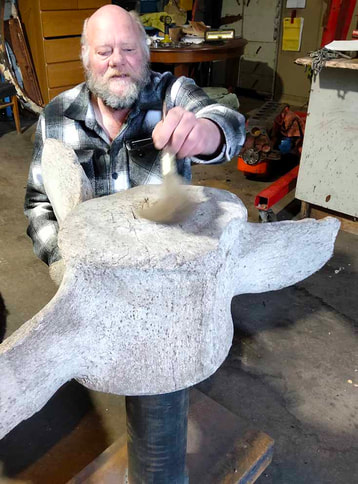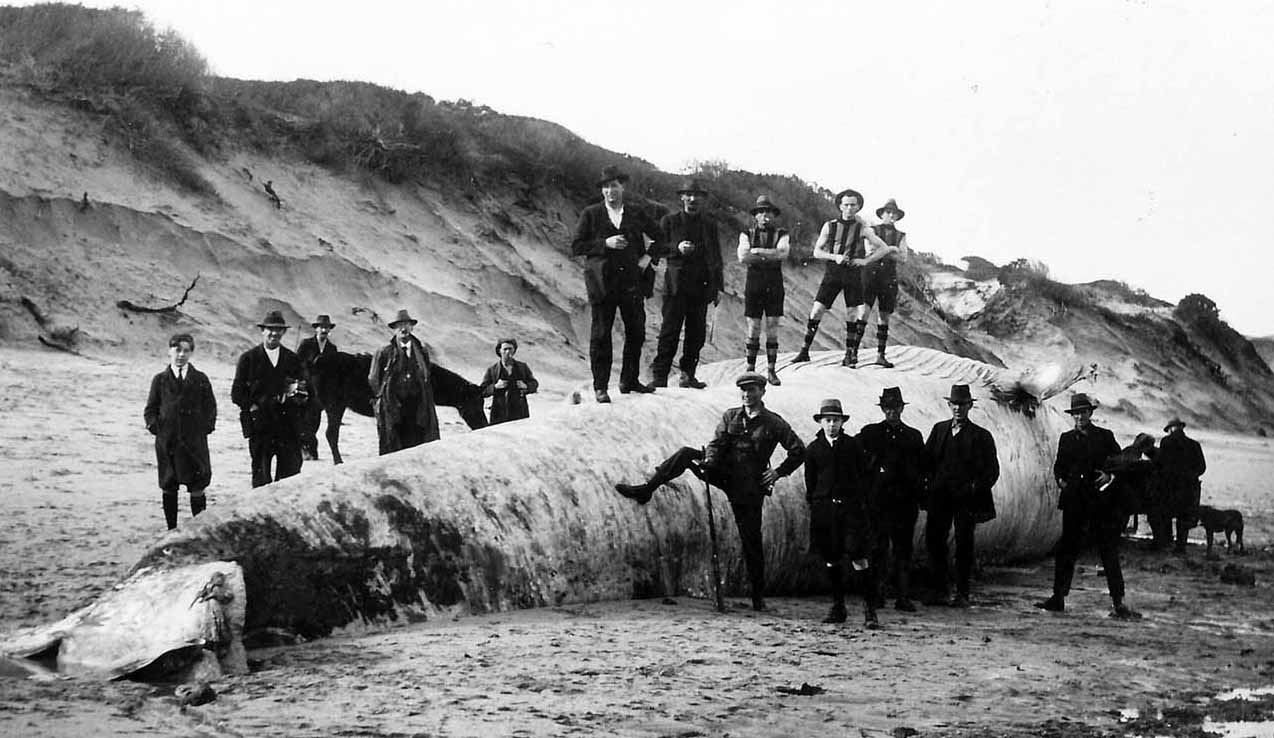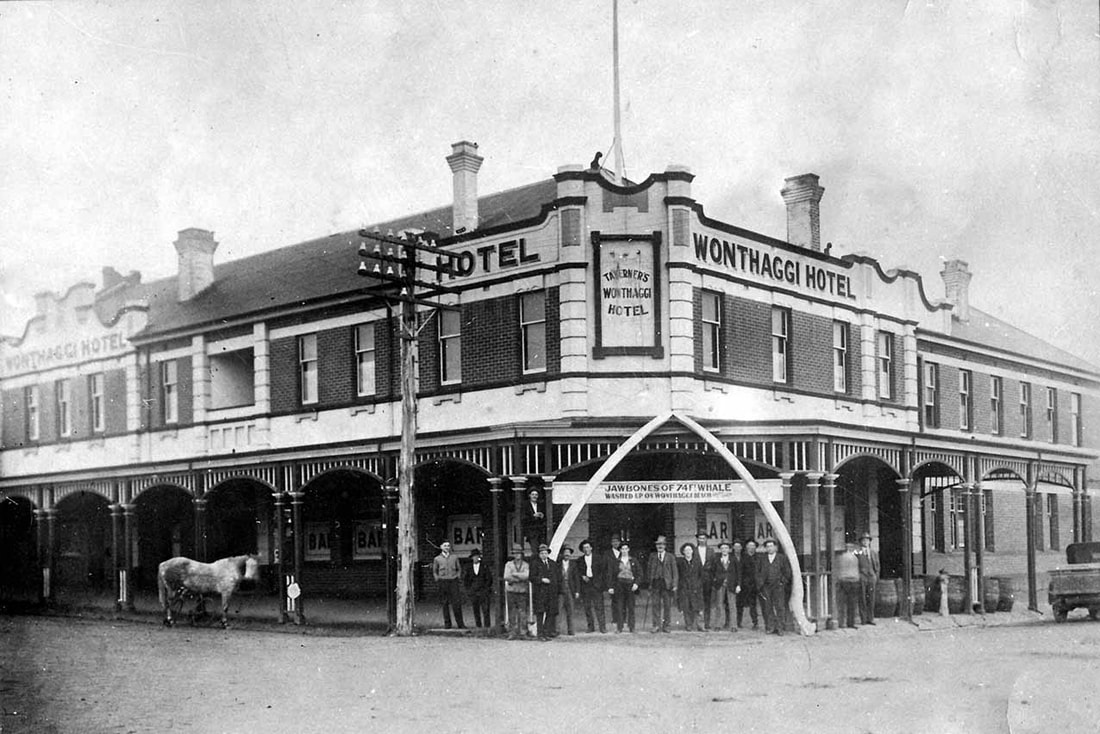
By Catherine Watson
OF ALL the objects in the Wonthaggi Museum, this is Mark Robertson’s favourite: a vertebra from the 74ft whale that washed up at Wreck beach, now Harmers Haven, 100 years ago (July 4th, 1923, to be exact) after heavy winter gales.
The centenary of the whale’s beaching was marked this month in typical Wonthaggi style. The Wonthaggi Hotel, AKA Taberners Hotel or The Whalebones, tied ribbons to the iconic whale jawbones at the front entrance. And on Thursday, members of the Wonthaggi Historical Society gathered for a supper of fish and chips and some good old-fashioned yarning about our whale.
OF ALL the objects in the Wonthaggi Museum, this is Mark Robertson’s favourite: a vertebra from the 74ft whale that washed up at Wreck beach, now Harmers Haven, 100 years ago (July 4th, 1923, to be exact) after heavy winter gales.
The centenary of the whale’s beaching was marked this month in typical Wonthaggi style. The Wonthaggi Hotel, AKA Taberners Hotel or The Whalebones, tied ribbons to the iconic whale jawbones at the front entrance. And on Thursday, members of the Wonthaggi Historical Society gathered for a supper of fish and chips and some good old-fashioned yarning about our whale.
Mark was one of the speakers, along with Faye Quilford, whose family lived near the beaching. Mark had dusted off the vertebra for the occasion and Adrian Cumin, our master engineer, had made a massive steel stand for it.
Mark related how his grandfather, Tom Ridley, went out to the beach to help cut up the whale and brought home the vertebra as a souvenir. For years it served as a pot plant stand on the Ridleys’ verandah in Broome Crescent.
When the house was sold, the vertebra came to Mark’s mother, Barbara, who was Tom’s stepdaughter. Mark remembers it being used as a chopping block until eventually his parents donated it to the museum. “So I’ve known it all my life.”
Mark doesn’t know how many vertebrae the whale had – possibly about 100 – but he doesn’t know of any others in the district.
On July 6, 1923, the Powlett Express reported “the magnitude of the monster”: it was 74 feet 6 inches long (22.3 metres), the tail was 13 feet (3.9 metres) wide, circumference 35 feet (10.5 metres) and the mouth was 17 feet (5.1 metres ) in diameter, “large enough to take a bullock”.
For their book Out to the Wreck, local historians Joe and Lyn Chambers interviewed locals who had made the long trek out to see the monster, including many school classes.
“Jack Phillips, who was eight at the time, has a vivid memory of seeing Jack Keighley, whose butcher’s cart was a familiar sight in the town. ‘Mr Keighley was standing on top of the whale and was chopping into the blubber with a brand new axe, while another man, Harold Pleydell, cut the chunks of fat away from the carcass.’
“The blubber was boiled down in a large steel boiler (borrowed from Thompson’s slaughter-yard). It is said the two men received £450 for their efforts, although it’s not clear whether this was from the sale of the oil or a fee from the Fisheries Department.
“Eric Middlemiss took his .303 rifle with him when he went to see the whale. He remembers standing on the whale and shooting at sharks which gathered near the water’s edge at high tide.
“It was patently obvious that the stranded beast was a male and for weeks after many ribald stories told of trenchant comments made by certain ‘ladies’ of the town.”
Mark says the whale was probably a pygmy blue whale, a baleen whale, that is a filter feeder without teeth. “The baleen was like finger nails. They used to make ladies’ corsets out of it.”
“Apparently it was pretty fresh. The miners and everyone here would have made use of every bit of the whale. They were into recycling. The alternative would have been to bury it or to blow it up with gelignite from the mine.”
The Chambers relate that the jawbones of the whale were bought by Charlie Taberner, the proprietor of the hotel. They lay in the backyard for a few years, and were bleached by sunlight before being put into position at the entrance. After that they were regularly whitewashed to preserve them.
And so the whalebones became our icon, Wonthaggi’s version of the Leaning Tower of Pisa or the Eiffel Tower. Over the decades, many thousands of tourists have been photographed under them.
They are also treasured by the local community. The Chambers’ account ends on a poignant note: “To the many hundreds of young people forced to find jobs away from their home town in the thirties and forties, rail travel was the only possible way of getting ‘home’ at Christmas and Easter. To walk under the whale-bones on your way from the station meant that you were really back again.”
Mark related how his grandfather, Tom Ridley, went out to the beach to help cut up the whale and brought home the vertebra as a souvenir. For years it served as a pot plant stand on the Ridleys’ verandah in Broome Crescent.
When the house was sold, the vertebra came to Mark’s mother, Barbara, who was Tom’s stepdaughter. Mark remembers it being used as a chopping block until eventually his parents donated it to the museum. “So I’ve known it all my life.”
Mark doesn’t know how many vertebrae the whale had – possibly about 100 – but he doesn’t know of any others in the district.
On July 6, 1923, the Powlett Express reported “the magnitude of the monster”: it was 74 feet 6 inches long (22.3 metres), the tail was 13 feet (3.9 metres) wide, circumference 35 feet (10.5 metres) and the mouth was 17 feet (5.1 metres ) in diameter, “large enough to take a bullock”.
For their book Out to the Wreck, local historians Joe and Lyn Chambers interviewed locals who had made the long trek out to see the monster, including many school classes.
“Jack Phillips, who was eight at the time, has a vivid memory of seeing Jack Keighley, whose butcher’s cart was a familiar sight in the town. ‘Mr Keighley was standing on top of the whale and was chopping into the blubber with a brand new axe, while another man, Harold Pleydell, cut the chunks of fat away from the carcass.’
“The blubber was boiled down in a large steel boiler (borrowed from Thompson’s slaughter-yard). It is said the two men received £450 for their efforts, although it’s not clear whether this was from the sale of the oil or a fee from the Fisheries Department.
“Eric Middlemiss took his .303 rifle with him when he went to see the whale. He remembers standing on the whale and shooting at sharks which gathered near the water’s edge at high tide.
“It was patently obvious that the stranded beast was a male and for weeks after many ribald stories told of trenchant comments made by certain ‘ladies’ of the town.”
Mark says the whale was probably a pygmy blue whale, a baleen whale, that is a filter feeder without teeth. “The baleen was like finger nails. They used to make ladies’ corsets out of it.”
“Apparently it was pretty fresh. The miners and everyone here would have made use of every bit of the whale. They were into recycling. The alternative would have been to bury it or to blow it up with gelignite from the mine.”
The Chambers relate that the jawbones of the whale were bought by Charlie Taberner, the proprietor of the hotel. They lay in the backyard for a few years, and were bleached by sunlight before being put into position at the entrance. After that they were regularly whitewashed to preserve them.
And so the whalebones became our icon, Wonthaggi’s version of the Leaning Tower of Pisa or the Eiffel Tower. Over the decades, many thousands of tourists have been photographed under them.
They are also treasured by the local community. The Chambers’ account ends on a poignant note: “To the many hundreds of young people forced to find jobs away from their home town in the thirties and forties, rail travel was the only possible way of getting ‘home’ at Christmas and Easter. To walk under the whale-bones on your way from the station meant that you were really back again.”

